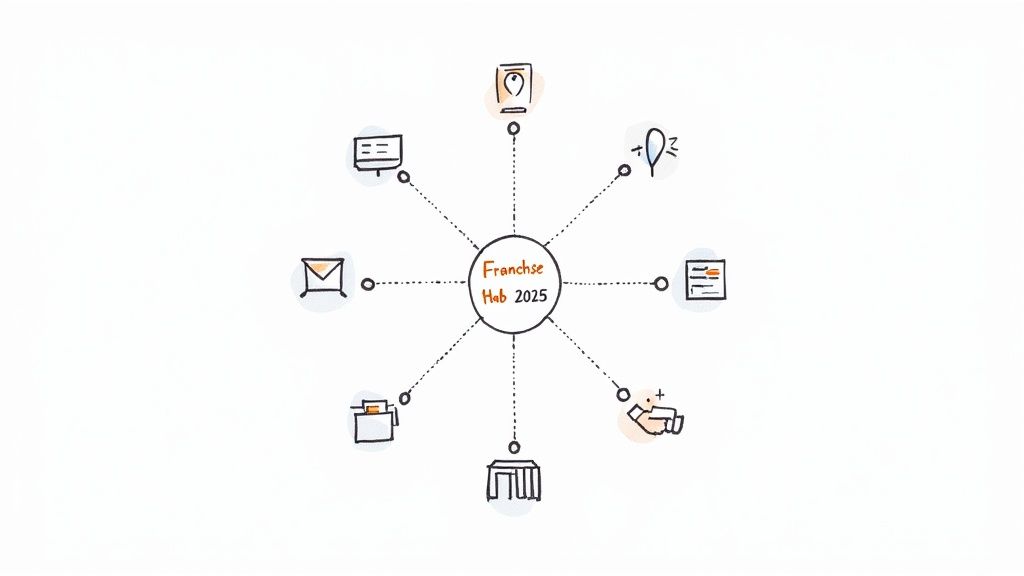
Mastering Inbound Lead Generation: Strategies for Sustainable Growth
Master inbound lead generation with strategies for sustainable growth. Learn content marketing, SEO, AI personalization, and more to attract qualified prospects.

Franchise marketing operates on a unique set of rules. It demands a delicate balance, requiring a powerful, consistent national brand identity that can also be adapted to resonate deeply within local communities. Standard, one-size-fits-all marketing advice often fails because it misses this critical dual-layered challenge. To scale a franchise system effectively, you need a playbook of proven, adaptable franchise marketing strategies that empower both corporate teams and individual franchisees.
This guide provides exactly that. We move beyond generic tips to deliver a comprehensive roundup of 10 powerful tactics that successful brands are using right now to drive growth. You won't find vague theories here. Instead, you'll get a clear roadmap for implementation, complete with actionable steps for each strategy.
You will learn how to:
Whether you're a franchisor looking to create a more cohesive marketing front or a franchisee aiming to dominate your local market, this article provides the specific insights needed to build a stronger brand presence and achieve sustainable growth. Let’s dive in.
Co-branding is a powerful franchise marketing strategy where two or more brands collaborate on a joint marketing initiative. By partnering with a complementary, non-competing brand, a franchise can tap into a new customer base, share marketing costs, and increase its perceived value. This approach works by leveraging the established trust and loyalty of another brand to enhance your own.
The core idea is to create a mutually beneficial relationship. For example, a fast-casual restaurant might partner with a local movie theater to offer a "dinner and a movie" discount package, creating a win-win scenario that drives traffic for both businesses.

This strategy is effective because it creates synergy. A classic example is the long-standing partnership between McDonald's and Disney, where Happy Meals feature toys from the latest Disney movies. This collaboration drives sales for both giants. Similarly, co-located brands like Dunkin' and Baskin-Robbins share real estate and operational costs while cross-promoting to each other’s customers.
Successfully launching a co-branding campaign requires careful planning and execution. Follow these steps:
Digital marketing and social media engagement is a modern franchise marketing strategy that leverages online channels to build brand presence and connect with customers. This involves a coordinated effort across social media, content marketing, SEO, and email campaigns. Typically, the franchisor creates overarching brand campaigns, while franchisees adapt them with a local focus.
The goal is to create a seamless online-to-offline experience. A customer might see a viral TikTok video from the national brand, then receive a targeted ad for a special offer at their nearest franchise location, driving them to visit in person.

This strategy works because it meets consumers where they spend their time: online. It allows for direct, two-way communication and builds a community around the brand. A prime example is Wendy's iconic and witty Twitter presence, which has cultivated a loyal following. Similarly, Domino's Pizza pioneered a digital-first ordering system, making it easy for customers to order from any device, which significantly boosted sales.
A successful digital presence requires a balance between corporate control and franchisee flexibility.
A loyalty program is a cornerstone of modern franchise marketing strategies, designed to reward repeat customers and increase their lifetime value. Instead of constantly spending on acquiring new customers, this approach focuses on retaining existing ones by offering exclusive benefits, points, or personalized incentives. For franchises, this creates a predictable revenue stream and builds a community of brand advocates.
These programs work by creating a cycle of engagement. A customer makes a purchase, earns a reward, and is incentivized to return to redeem it, often making another purchase in the process. The data collected provides invaluable insights into customer behavior.

This strategy is highly effective because it costs far less to retain an existing customer than to acquire a new one. Loyalty programs tap into the human desire for recognition. Starbucks has perfected this with the Starbucks Rewards app, which seamlessly integrates mobile ordering with a tiered rewards system. Similarly, the Chipotle Rewards program offers points for every purchase, creating a powerful incentive for repeat visits.
Launching a successful loyalty program requires technology, valuable offers, and clear communication.
Local marketing and community involvement is one of the most effective franchise marketing strategies for building a loyal customer base. This approach empowers individual franchisees to connect with their immediate community through hyper-local initiatives, transforming a national brand into a trusted neighborhood staple. It involves sponsoring local sports teams, participating in community events, and building genuine relationships.
This strategy recognizes that even global brands operate on a local level. By tailoring outreach to the specific needs and values of the local community, franchisees can create a powerful, authentic connection that national campaigns alone cannot achieve.

This strategy works because people prefer to support businesses that invest in their community. A prime example is Chick-fil-A, whose operators are famous for sponsoring local school events and fundraisers, building immense goodwill. Similarly, Anytime Fitness gyms often partner with local health initiatives, positioning themselves as integral parts of the community's health ecosystem.
Effective local marketing requires a balance between franchisee autonomy and brand consistency.
Franchise marketing co-ops are a collaborative funding model where franchisees in a specific region contribute to a shared marketing fund. This pooled money is then used to launch larger-scale advertising campaigns that a single location could never afford alone. The franchisor often helps manage this fund, ensuring brand consistency while empowering local owners.
The core idea is to leverage collective buying power. Instead of one franchisee paying for a small radio spot, a regional co-op can buy primetime television ads or prominent billboards, amplifying the brand’s presence for every contributing member.
This strategy combines the financial power of a large corporation with the local market knowledge of franchisees. A prime example is McDonald's, which organizes its franchisees into regional co-ops. These groups vote on and fund local marketing initiatives that complement national campaigns. Similarly, Burger King's advertising cooperatives give franchisees a direct say in how marketing dollars are spent in their market.
Establishing a successful marketing co-op requires clear governance and transparency.
Experiential marketing moves beyond passive advertising to create memorable, interactive events for customers. This approach engages multiple senses to foster a deep emotional connection with the brand through pop-up shops, in-store activations, and other immersive installations. The goal is to create a lasting impression that builds brand loyalty and generates word-of-mouth buzz.
This strategy is about letting customers "live" the brand. For example, a fitness franchise could organize a free public workout session in a park. These experiences associate the brand with positive, community-oriented feelings, making it far more memorable than a standard ad.
This strategy is effective because it creates genuine, shareable moments. Starbucks has mastered this with its Reserve Roastery locations, which offer immersive coffee tasting experiences that elevate the brand. Similarly, Chipotle's "Food With Integrity" events have included festivals that connect customers to its mission of sustainable sourcing. These experiences turn customers into brand advocates.
Launching a successful brand experience requires creativity and careful planning. To learn more, explore this guide on What Is Experiential Marketing? Your Ultimate Guide.
Content marketing focuses on creating and distributing valuable, relevant content to attract and retain a defined audience. Instead of directly pitching products, this approach positions the franchise as a trusted expert by educating customers through blogs, videos, and guides.
The core idea is to build authority and foster long-term relationships. A franchisor can create a library of high-quality content that individual franchisees can then adapt and share within their local communities, ensuring brand consistency while empowering local owners.
This strategy is effective because it builds trust and top-of-mind awareness. A home improvement franchise that publishes "how-to" maintenance guides helps homeowners before they even need a professional, making them the first call when an issue arises. Anytime Fitness offers free workout videos and fitness tips, providing value that strengthens its community and establishes credibility.
A successful content marketing plan requires a systematic approach.
Performance marketing is a strategy where advertising is paid for only when a specific action, such as a lead or sale, is completed. It’s a results-oriented approach that relies on data analytics to track the customer journey, ensuring every dollar spent is measurable and tied to ROI.
The core idea is to shift from paying for ad space to paying for tangible results. Franchisors can leverage this by providing franchisees with analytics dashboards to monitor campaign effectiveness in real time, allowing for continuous optimization.
This strategy is effective because it removes guesswork and focuses on accountability. Domino's Pizza uses data analytics to optimize everything from online ordering funnels to promotional email timing. Many franchises use Google Ads for local marketing, paying only when a potential customer clicks on an ad for their specific location, minimizing financial risk.
Launching a data-driven campaign requires a structured approach to tracking and analysis.
Influencer marketing involves partnering with individuals who have a dedicated social following to promote your brand. This approach leverages the trust influencers have built with their audience, turning their authentic recommendations into powerful endorsements for your franchise locations.
The core idea is to tap into niche communities through voices that already resonate with them. For example, a local fitness influencer could document their workout journey at an Anytime Fitness franchise, showcasing the facilities to their fitness-savvy followers.
This strategy is highly effective because it builds social proof and drives targeted traffic. A prime example is the collaboration between fast-food franchises and TikTok creators. A creator making a unique "menu hack" video at a local McDonald's can go viral, driving countless customers to that location. Long-term partnerships, like athletes endorsing Gatorade, create a deep association between excellence and the brand.
A successful influencer program requires finding the right partners and setting clear goals.
Omnichannel marketing creates a seamless and unified customer experience across all channels and touchpoints. Unlike a multichannel approach where channels operate independently, an omnichannel strategy integrates them, allowing customers to move fluidly between a physical store, the website, a mobile app, and social media without friction.
The goal is to make the entire customer journey cohesive. For instance, a customer might see a product on social media, browse it on the app, add it to their cart on a desktop, and then pick it up in a store. An omnichannel approach ensures this entire process is smooth.
This strategy mirrors modern consumer behavior. Today’s customers expect convenience and personalization. Starbucks excels at this with its mobile app, which integrates rewards, mobile ordering, and in-store payments into one seamless experience. Similarly, Domino's Pizza allows customers to order through a website, app, smart speaker, or social media, with a unified Pizza Tracker on all platforms.
Integrating your customer journey requires a deep understanding of your audience and technology.
The true power of these franchise marketing strategies is not found in any single component but in how they are integrated to create a cohesive engine that drives consistent growth for both the franchisor and each franchisee.
Throughout this guide, we've explored ten distinct yet interconnected strategies. The common thread is synergy; a powerful social media campaign is made stronger when it promotes a local in-store event, which in turn can be amplified by local influencers.
The leap from executing individual marketing tactics to managing an integrated system is what separates good franchise brands from great ones. This creates a virtuous cycle where one successful initiative fuels the next.
The most critical takeaway is this: your marketing should never operate in a silo.
This integrated approach requires a robust framework supported by both the franchisor and the franchisees. The franchisor provides the brand vision and national campaign assets, while franchisees bring local market expertise and on-the-ground execution.
So, where do you begin? Start with a candid audit of your current efforts. Identify which of these ten strategies are already in place and which represent the biggest opportunities for growth.
Building a world-class marketing engine is a marathon, not a sprint. By thoughtfully combining the franchise marketing strategies we've covered, you can build a sustainable system that not only attracts new customers but transforms them into lifelong advocates for your brand, driving success across your entire franchise network.
Ready to build a high-performance marketing engine without the guesswork? BrandBooster.ai combines AI-powered insights with expert execution to design, implement, and manage integrated franchise marketing strategies that deliver measurable results. Visit BrandBooster.ai to see how we can help you accelerate growth across your entire network.